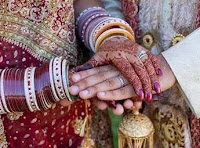CONFLUENCE OF CULTURES
HINDU AND MUSLIM WOMEN
HINDU AND MUSLIM WOMEN
 The Times of India - (New Delhi) As burqa-clad Sumaira walks past the streets of Jama Masjid, there's nothing really striking about her. That's until she flashes the bright red bangles she's wearing - the kind that newly married Hindu women have around their wrists. Young Muslim women in India, and even Pakistan, can be increasingly seen sporting the chooda, mangalsutra and often the sindoor. And they see no taboo in it, taking it as a fashion statement, something that adds to their 'just married' look.
The Times of India - (New Delhi) As burqa-clad Sumaira walks past the streets of Jama Masjid, there's nothing really striking about her. That's until she flashes the bright red bangles she's wearing - the kind that newly married Hindu women have around their wrists. Young Muslim women in India, and even Pakistan, can be increasingly seen sporting the chooda, mangalsutra and often the sindoor. And they see no taboo in it, taking it as a fashion statement, something that adds to their 'just married' look.''Wearing a chooda doesn't make me a Hindu or a lesser Muslim," says 21-year-old Sumaira. "See, among Muslims there is nothing that differentiates married women from those who are still single. I have been fascinated with choodas ever since I was a kid. So that was one of the first things I bought after my engagement. In fact, my cousin Saima, too, wore one at her nikah."
.jpg) It's not only the chooda. The demand for mangalsutras is picking up, and not just in India but also in Pakistan where many of those who ask for it attribute it to the influence of India's enormously popular saas-bahu soaps. "Mangalsutra is a beautiful neckpiece and goes with every suit," Naseema Aziz, a resident of Karachi, explains. "If one is wearing it out of choice, there's nothing wrong in it. In Pakistan everyone knows I am a Muslim. Merely wearing a mangalsutra won't have me confused for a Hindu."
It's not only the chooda. The demand for mangalsutras is picking up, and not just in India but also in Pakistan where many of those who ask for it attribute it to the influence of India's enormously popular saas-bahu soaps. "Mangalsutra is a beautiful neckpiece and goes with every suit," Naseema Aziz, a resident of Karachi, explains. "If one is wearing it out of choice, there's nothing wrong in it. In Pakistan everyone knows I am a Muslim. Merely wearing a mangalsutra won't have me confused for a Hindu." With the mangalsutra and chooda finding favour among Muslim women, how can the sindoor, that eternal sign of a married Hindu girl, be left behind? But while most Hindu women prefer red sindoor, Muslims tend to go for orange. Interestingly, in parts of Kolkata the two different shades have come to distinguish women from the two communities. In Bihar, however, many Hindu women also use orange sindoor.
WHAT DO THE VEDIC TEACHINGS TELL US?
 A Hindu wedding is essentially a ceremony of sacred rites and rituals. ... The bridegroom adorns the bride with Mangal Sutra, by putting the auspicious black-beaded ornament around her neck. Panigrahan - holding hands to accept the vows and exchanging the places - is a ritual of sacred vows. The bridegroom applies sindoor, vermillion, in the parting of the bride’s hair as an auspicious symbol of her married status, followed by Shantipath - the peace invocations. ... Hindu scriptures implore upon every man to love and care for his wife, despite any shortcomings. He is forbidden to strike or speak harshly to her or ignore her needs. ... Hindu theology regards the ideal marriage as a spiritual journey, where the man and woman must complement and help one another toward divine realization. The path is often long and arduous; the spiritual awakening comes through many experiences on the physical plane.
A Hindu wedding is essentially a ceremony of sacred rites and rituals. ... The bridegroom adorns the bride with Mangal Sutra, by putting the auspicious black-beaded ornament around her neck. Panigrahan - holding hands to accept the vows and exchanging the places - is a ritual of sacred vows. The bridegroom applies sindoor, vermillion, in the parting of the bride’s hair as an auspicious symbol of her married status, followed by Shantipath - the peace invocations. ... Hindu scriptures implore upon every man to love and care for his wife, despite any shortcomings. He is forbidden to strike or speak harshly to her or ignore her needs. ... Hindu theology regards the ideal marriage as a spiritual journey, where the man and woman must complement and help one another toward divine realization. The path is often long and arduous; the spiritual awakening comes through many experiences on the physical plane.
Dr. Hiro Badlani:
“Hinduism - Path of the Ancient Wisdom”
Chapter 50: “Hindu Wedding”
“Nuptials for Eternity” - http://hinduismpath.com/
http://hinduismpath.com/book-contents/chapter-50/
“Hinduism - Path of the Ancient Wisdom”
Chapter 50: “Hindu Wedding”
“Nuptials for Eternity” - http://hinduismpath.com/
http://hinduismpath.com/book-contents/chapter-50/
Published by dasavatara das - "Vedic Views on World News"
http://www.vedicviews-worldnews.blogspot.com.ar/
http://www.vedicviews-worldnews.blogspot.com.ar/

No comments:
Post a Comment